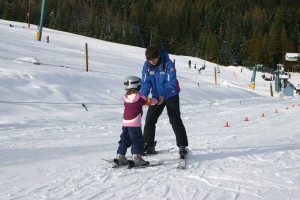Learning To Ski is Easy

Few sensations can be compared to gliding down the mountain on a pair of skis with the greatest of ease. Spending the day on the mountain with family and friends, hitting the terrain parks for a few bumps and jumps, stopping by the lodge on the top of the mountain for a cup of hot chocolate; a day spent on skis is a day spent in heaven some would say.
Whether you are a first-time skier or a seasoned pro, before you hit the mountain there are some basic tips and tricks of the trade that can help enhance your experience.
JANUARY IS LEARN TO SKI AND SNOWBOARD MONTH
Click here to find a learn-to-ski program near you!
TIPS WHILE ON THE SLOPES
- Take a lesson. Like anything, you’ll improve the most when you receive some guidance. The best way to become a good skier or snowboarder is to take a lesson from a qualified instructor.
- The key to successful skiin
g/snowboarding is control. To have it, you must be aware of your technique, the terrain and the skiers/snowboarders around you. Be aware of the snow conditions and how they can change. As conditions turn firm, the skiing gets hard and fast. Begin a run slowly.
- Skiing and snowboarding require a mental and physical presence.
- If you find yourself on a slope that exceeds your ability level, always leave your skis/snowboard on and side step down the slope.
- The all-important warm-up run prepares you mentally and physically for the day ahead.
- Drink plenty of water. Be careful not to become dehydrated.
- Curb alcohol consumption. Skiing and snowboarding do not mix well with alcohol or drugs.
- Know your limits. Learn to ski and snowboard smoothly—and in control. Stop before you become fatigued and, most of all have fun.
- If you’re tired, stop skiing. In this day and age of multi-passenger gondolas and high-speed chair lifts, you can get a lot more time on the slopes compared to the days of the past when guests were limited to fixed grip chair lifts.
LESSONS
Don’t even think of not taking a lesson, or worse, letting your friend, spouse or cousin teach you. Search for Learn-to-Ski/Snowboard packages. Each package usually includes a two or three-hour lesson, rental equipment for the day, and if appropriate, a lift ticket.
TIPS PRIOR TO HITTING THE SLOPES
- Get in shape. Don’t try to ski yourself into shape. You’ll enjoy skiing more if you’re physically fit.
- Obtain proper equipment. Be sure to have your ski or snowboard bindings adjusted correctly at a local ski shop. You can rent good ski or snowboarding equipment at resorts.
- When buying ski wear, look for fabric that is water and wind-resistant. Look for wind flaps to shield zippers, snug cuffs at wrists and ankles, collars that can be snuggled up to the chin and drawstrings that can be adjusted for comfort and keep wind out. Be sure to buy quality clothing and products.
- Dress in layers. Layering allows you to accommodate your body’s constantly changing temperature. For example, dress in polypropylene underwear (top and bottoms), which feels good next to the skin, dries quickly, absorbs sweat and keeps you warm. Wear a turtleneck, sweater and jacket.
- Be prepared. Mother Nature has a mind of her own. Bring a headband or hat with you to the slopes, 60 percent of heat-loss is through the head. Wear gloves or mittens (mittens are usually better for those susceptible to cold hands).
- Wear sun protection. The sun reflects off the snow and is stronger than you think, even on cloudy days!
- Always wear eye protection. Have sunglasses and goggles with you. Skiing and snowboarding are a lot more fun when you can see.
